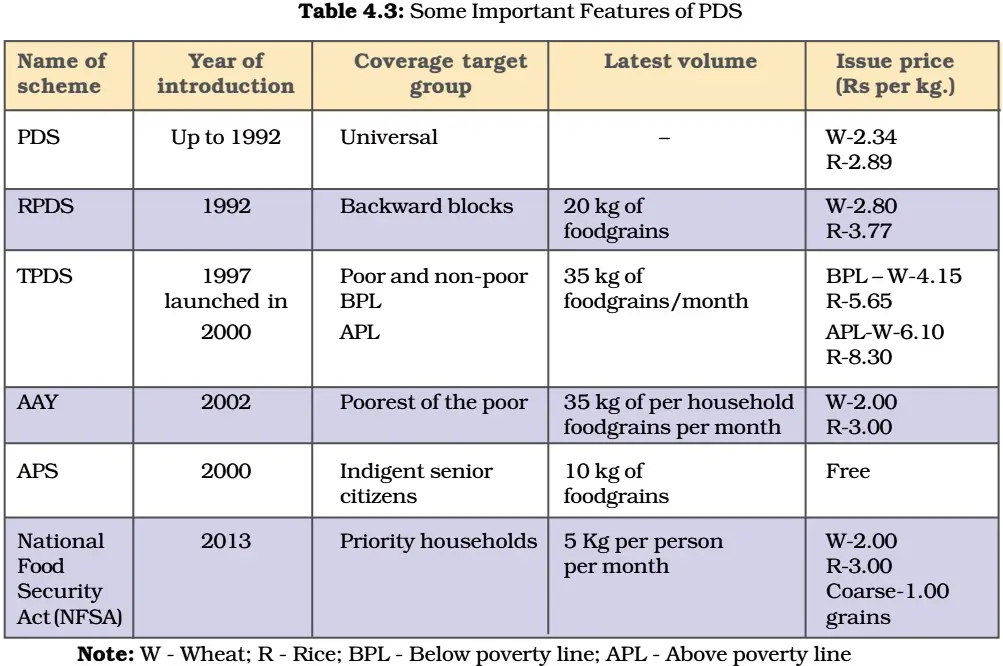Revision Notes of Economics for Class 9 Chapter 4 Food Security in India
Revision Notes of Economics Chapter 4 deals with the Food Security and role of PDS systems in India.
Food is as essential for living as air is for breathing. But food security means something more than getting two square meals.
Food Security
It means availability, accessibility and affordability of food to all people at all times. It has following dimensions:
- Availability of food: It means food production within the country, food imports and the previous year’s stock stored in government granaries.
- Accessibility: It means food is within reach of every person.
- Affordability: It implies that an individual has enough money to buy sufficient, safe and nutritious food to meet one’s dietary needs.
Hunger
Hunger is another aspect indicating food insecurity. It is not just an expression of poverty; it brings about poverty.
Hunger has two dimensions: Chronic and Seasonal.
- Chronic Hunger is a consequence of diets persistently inadequate in terms of quantity and/or quality.
- Seasonal Hunger is related to cycles of food growing and harvesting. This is prevalent in rural areas because of the seasonal nature of agricultural activities and in urban areas because of casual labourers.
Need of food security
- To ensure the welfare of the poorest section of the society.
- To deal with emergency or catastrophic situations such as earthquakes, floods, droughts, famines etc.
People vulnerable to food insecurity
- The worst affected groups are landless people with little or no land to depend upon, traditional artisans, providers of traditional services, petty self-employed workers and destitute including beggars.
- In the urban areas, the food insecure families are those whose working members are generally employed in ill-paid occupations and casual labour market.
- The SCs, STs and some sections of the OBCs (lower castes among them) who have either poor landbase or very low land productivity are prone to food insecurity.
- The people affected by natural disasters, who must migrate to other areas in search of work.
- A large proportion of pregnant and nursing mothers and children under the age of 5 years constitute an important segment of the food insecure population.
Food Security in India
Since the advent of the Green Revolution in the early-1970s, the country has avoided famine even during adverse weather conditions.
- India has become self-sufficient in food grains during the last 30 years because of a variety of crops grown all over the country. The availability of food grains (even in adverse weather conditions or otherwise) at the country level has further been ensured with a carefully designed food security system by the government.
This system has two components:
Buffer Stock
- It is the stock of food grains, namely wheat and rice, procured by the government through the Food Corporation of India (FCI).
- The farmers are paid a preannounced price for their crops called Minimum Support Price (MSP). It is declared every year before the sowing season to provide incentives to farmers for raising the production of these crops.
- The purchased food grains are stored in granaries.
- The buffer stock is created to distribute food grains in the deficit areas and among the poorer strata of the society at a price lower than the market price also known as Issue Price.
Public Distribution System:
- The food procured by the FCI is distributed through government regulated ration shops among the poorer section of the society. This is called the Public Distribution System (PDS).
- Ration shops (also known as Fair Price Shops) are now present in most localities, villages, towns and cities. There are about 5.5 lakh ration shops all over the country.
- Any family with a ration card can buy a stipulated amount of these items (e.g., 35 kg of grains, 5 litres of kerosene, 5 kg of sugar etc.) every month from the nearby ration shop.
Current Status of the Public Distribution System:
- PDS System has gone through various changes in the course of time, they are as follows:
- Further, in 2000, two special schemes were launched viz., Antyodaya Anna Yojana (AAY) and Annapurna Scheme (APS) with special target groups of ‘poorest of the poor’ and ‘indigent senior citizens’, respectively.
Problems in the working of PDS system:
- FCI godowns are overflowing with grains, with some rotting away and some being eaten by rats.
- High carrying costs, in addition to wastage and deterioration in grain quality due to high stock levels.
- The procurement is concentrated in a few prosperous regions (Punjab, Haryana, Western Uttar Pradesh, Andhra Pradesh and to a lesser extent in West Bengal) and mainly of two crops— wheat and rice— increase in MSP has induced farmers, particularly in surplus states, to divert land from production of coarse grains, which is the staple food of the poor, to the production of rice and wheat.
- Environmental degradation and fall in the water level due to intensive utilisation of water in the cultivation of rice.
- PDS dealers are sometimes found resorting to malpractices like diverting the grains to open market to get better margin, selling poor quality grains at ration shops, irregular opening of the shops, etc.
- Now, with TPDS (Targeted Public Distribution System) because of three different prices, any family above the poverty line gets very little discount at the ration shop. The price for APL family is almost as high as open market price, so there is little incentive for them to buy these items from the ration shop.
Role of cooperatives in food security
The cooperatives are also playing an important role in food security in India especially in the southern and western parts of the country. Various examples include:
- In Tamil Nadu, around 94 per cent of fair price shops are being run by the cooperatives.
- In Delhi, Mother Dairy is making strides in provision of milk and vegetables to the consumers at controlled rate decided by Government of Delhi.
- Amul is another success story of cooperatives in milk and milk products from Gujarat.
- In Maharashtra, Academy of Development Science (ADS) has facilitated a network of NGOs for setting up grain banks in different regions. ADS organises training and capacity building programmes on food security for NGOs.
Interesting points
- The White revolution is referred to increased milk production in the country due to cooperative sector.
The National Food Security Act, 2013:
- This Act provides for food and nutritional security life at affordable prices and enables people to live a life with dignity.
- It provides for 75% of the rural population and 50% of the urban population as eligible households for food security.
- The introduction of Rationing in India dates back to the 1940s against the backdrop of the Bengal famine.
Subsidy
It is a payment that a government makes to a producer to supplement the market price of a commodity. Subsidies can keep consumer prices low while maintaining a higher income for domestic producers.





